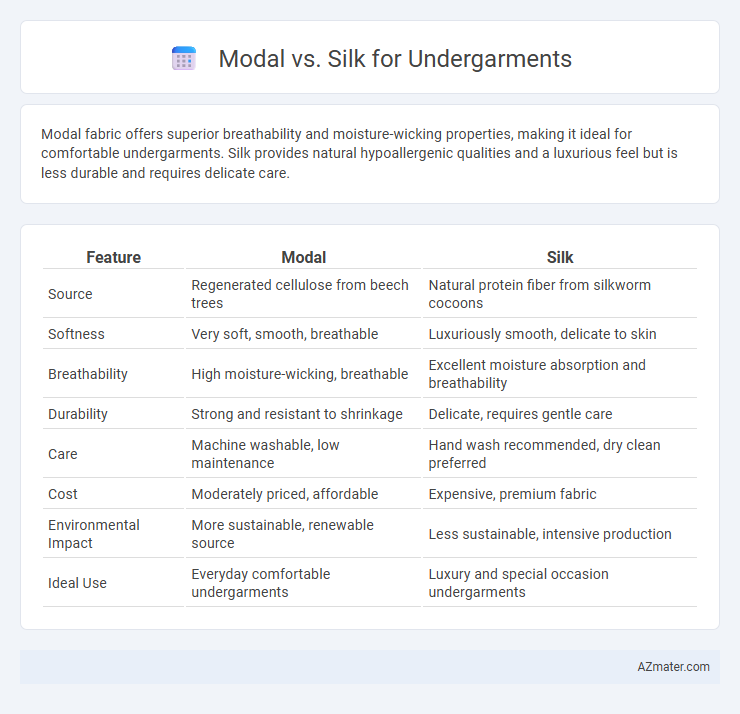Modal fabric offers superior breathability and moisture-wicking properties, making it ideal for comfortable undergarments. Silk provides natural hypoallergenic qualities and a luxurious feel but is less durable and requires delicate care.
Table of Comparison
| Feature | Modal | Silk |
|---|---|---|
| Source | Regenerated cellulose from beech trees | Natural protein fiber from silkworm cocoons |
| Softness | Very soft, smooth, breathable | Luxuriously smooth, delicate to skin |
| Breathability | High moisture-wicking, breathable | Excellent moisture absorption and breathability |
| Durability | Strong and resistant to shrinkage | Delicate, requires gentle care |
| Care | Machine washable, low maintenance | Hand wash recommended, dry clean preferred |
| Cost | Moderately priced, affordable | Expensive, premium fabric |
| Environmental Impact | More sustainable, renewable source | Less sustainable, intensive production |
| Ideal Use | Everyday comfortable undergarments | Luxury and special occasion undergarments |
Introduction to Modal and Silk Fabrics
Modal fabric, derived from beech tree pulp, is renowned for its exceptional softness, breathability, and moisture-wicking properties, making it ideal for undergarments. Silk, a natural protein fiber produced by silkworms, offers a luxurious feel, excellent temperature regulation, and hypoallergenic benefits. Both fabrics provide superior comfort, but Modal emphasizes durability and easy care, whereas Silk is prized for its smooth texture and elegant appearance.
Key Differences Between Modal and Silk
Modal fabric is a semi-synthetic fiber derived from beech tree pulp, known for its softness, breathability, and moisture-wicking properties, making it ideal for everyday undergarments. Silk, a natural protein fiber produced by silkworms, offers a luxurious feel, excellent temperature regulation, and a smooth texture that is gentle on sensitive skin. Key differences include Modal's durability and easier care compared to silk's delicate nature, higher cost, and superior natural hypoallergenic qualities.
Comfort and Feel: Modal vs Silk
Modal fabric offers exceptional softness and breathability, making it highly comfortable and moisture-wicking for undergarments. Silk provides a smooth, luxurious feel against the skin with natural temperature-regulating properties that keep wearers cool in summer and warm in winter. Both materials excel in softness, but modal's durability and stretchability offer a more practical choice for everyday comfort.
Breathability and Moisture Wicking Properties
Modal fabric offers superior breathability and moisture-wicking properties compared to silk, making it ideal for undergarments designed for active use or warm climates. Modal is derived from beech tree pulp and is highly absorbent, efficiently drawing moisture away from the skin to keep the wearer dry and comfortable. Silk, while naturally breathable and hypoallergenic, tends to retain moisture longer, which can reduce its effectiveness for moisture management during intense physical activity.
Durability and Longevity of Modal and Silk Undergarments
Modal undergarments exhibit superior durability compared to silk, maintaining their shape and color after multiple washes thanks to the fabric's high tensile strength and resistance to pilling. Silk undergarments, while luxurious and soft, tend to be more delicate, requiring gentle care to avoid damage such as snags or weakening of fibers, which can shorten their lifespan. Choosing modal ensures longer-lasting wear and easier maintenance, making it ideal for everyday use, whereas silk is best reserved for special occasions due to its fragile nature.
Sustainability and Eco-Friendliness
Modal fabric, derived from beech tree pulp, offers a sustainable alternative to traditional textiles due to its biodegradable nature and lower water consumption during production compared to cotton. Silk, while natural and biodegradable, involves intensive resource use and ethical concerns related to sericulture, impacting its overall eco-friendliness. Choosing Modal for undergarments supports sustainable fashion through reduced environmental footprint and renewable raw materials, whereas Silk's sustainability is often compromised by higher energy use and animal welfare issues.
Skin Sensitivity and Hypoallergenic Qualities
Modal fabric, derived from beech tree pulp, offers exceptional softness and breathability, making it ideal for sensitive skin by reducing irritation and promoting moisture control. Silk, a natural protein fiber, is inherently hypoallergenic and gentle, minimizing allergic reactions and providing smooth comfort for delicate skin types. Both materials excel in skin sensitivity, but Modal's moisture-wicking properties give it a slight advantage in maintaining dryness and preventing skin discomfort.
Care and Maintenance Tips
Modal undergarments require gentle washing in cold water and air drying to maintain their softness and prevent shrinking, while silk undergarments demand hand washing with mild detergent and avoiding direct sunlight to preserve their delicate fibers and sheen. Both fabrics benefit from storing in a cool, dry place away from rough surfaces to prevent pilling and snagging, with silk needing extra caution to avoid exposure to harsh chemicals like bleach. Proper care extends the lifespan and comfort of modal and silk undergarments, ensuring their luxurious texture and durability over time.
Price Comparison and Value for Money
Modal undergarments typically offer a higher price point compared to silk but provide excellent durability and moisture-wicking properties, enhancing overall comfort. Silk, while often more expensive, excels in luxury feel and natural temperature regulation, making it a premium choice for sensitive skin and special occasions. In terms of value for money, modal is ideal for everyday wear due to its cost-effectiveness and resilience, whereas silk delivers superior quality and indulgence worth the investment for luxury preference.
Choosing the Best Fabric for Your Undergarments
Modal fabric offers exceptional softness, breathability, and moisture-wicking properties, making it ideal for active, everyday wear undergarments that require comfort and durability. Silk stands out for its luxurious feel, natural temperature regulation, and hypoallergenic qualities, perfect for special occasions or sensitive skin needs. When choosing the best fabric for undergarments, consider factors such as breathability, moisture management, skin sensitivity, and intended use to determine whether Modal's practicality or Silk's elegance better suits your lifestyle.

Infographic: Modal vs Silk for Undergarment
 azmater.com
azmater.com